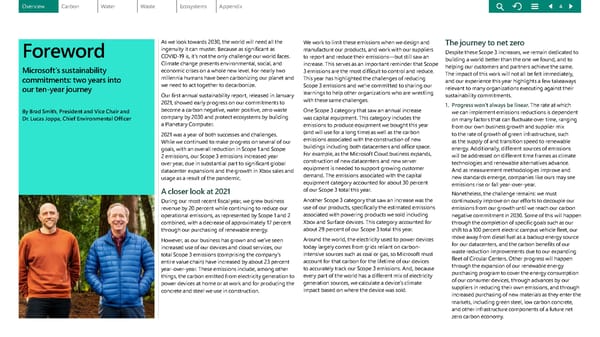Foreword Microsoft’s sustainability commitments: two years into our ten-year journey By Brad Smith, President and Vice Chair and Dr. Lucas Joppa, Chief Environmental Officer As we look towards 2030, the world will need all the ingenuity it can muster. Because as significant as COVID -19 is, it’s not the only challenge our world faces. Climate change presents environmental, social, and economic crises on a whole new level. For nearly two millennia humans have been carbonizing our planet and we need to act together to decarbonize. Our first annual sustainability report, released in January 2021, showed early progress on our commitments to become a carbon negative, water positive, zero waste company by 2030 and protect ecosystems by building a Planetary Computer. 2021 was a year of both successes and challenges. While we continued to make progress on several of our goals, with an overall reduction in Scope 1 and Scope 2 emissions, our Scope 3 emissions increased year over year, due in substantial part to significant global datacenter expansions and the growth in Xbox sales and usage as a result of the pandemic. A closer look at 2021 During our most recent fiscal year, we grew business revenue by 20 percent while continuing to reduce our operational emissions, as represented by Scope 1 and 2 combined, with a decrease of approximately 17 percent through our purchasing of renewable energy. However, as our business has grown and we’ve seen increased use of our devices and cloud services, our total Scope 3 emissions (comprising the company’s entire value chain) have increased by about 23 percent year-over-year. These emissions include, among other things, the carbon emitted from electricity generation to power devices at home or at work and for producing the concrete and steel we use in construction. We work to limit these emissions when we design and manufacture our products, and work with our suppliers to report and reduce their emissions—but still saw an increase. This serves as an important reminder that Scope 3 emissions are the most difficult to control and reduce. This year has highlighted the challenges of reducing Scope 3 emissions and we’re committed to sharing our learnings to help other organizations who are wrestling with these same challenges. One Scope 3 category that saw an annual increase was capital equipment. This category includes the emissions to produce equipment we bought this year (and will use for a long time) as well as the carbon emissions associated with the construction of new buildings including both datacenters and office space. For example, as the Microsoft Cloud business expands, construction of new datacenters and new server equipment is needed to support growing customer demand. The emissions associated with the capital equipment category accounted for about 30 percent of our Scope 3 total this year. Another Scope 3 category that saw an increase was the use of our products, specifically the estimated emissions associated with powering products we sold including Xbox and Surface devices. This category accounted for about 29 percent of our Scope 3 total this year. Around the world, the electricity used to power devices today largely comes from grids reliant on carbon- intensive sources such as coal or gas, so Microsoft must account for that carbon for the lifetime of our devices to accurately track our Scope 3 emissions. And, because every part of the world has a different mix of electricity generation sources, we calculate a device’s climate impact based on where the device was sold. The journey to net zero Despite these Scope 3 increases, we remain dedicated to building a world better than the one we found, and to helping our customers and partners achieve the same. The impact of this work will not all be felt immediately, and our experience this year highlights a few takeaways relevant to many organizations executing against their sustainability commitments. 1. Progress won’t always be linear. The rate at which we can implement emissions reductions is dependent on many factors that can fluctuate over time, ranging from our own business growth and supplier mix to the rate of growth of green infrastructure, such as the supply of and transition speed to renewable energy. Additionally, different sources of emissions will be addressed on different time frames as climate technologies and renewable alternatives advance. And as measurement methodologies improve and new standards emerge, companies like ours may see emissions rise or fall year-over-year. Nonetheless, the challenge remains: we must continuously improve on our efforts to decouple our emissions from our growth until we reach our carbon negative commitment in 2030. Some of this will happen through the completion of specific goals such as our shift to a 100 percent electric campus vehicle fleet, our move away from diesel fuel as a backup energy source for our datacenters, and the carbon benefits of our waste reduction improvements due to our expanding fleet of Circular Centers. Other progress will happen through the expansion of our renewable energy purchasing program to cover the energy consumption of our consumer devices, through advances by our suppliers in reducing their own emissions, and through increased purchasing of new materials as they enter the markets, including green steel, low carbon concrete, and other infrastructure components of a future net zero carbon economy. 4
 Environmental Sustainability Report | Microsoft Page 3 Page 5
Environmental Sustainability Report | Microsoft Page 3 Page 5